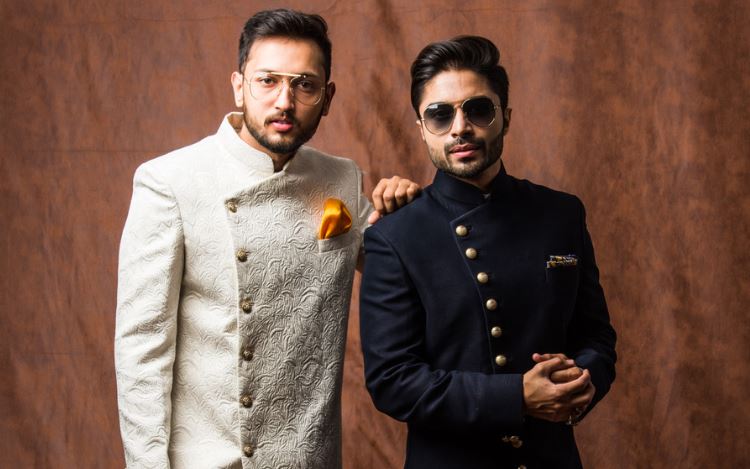Haryana, a state known for its rich cultural heritage and rural simplicity, reflects its deep-rooted traditions through its clothing. The Haryana traditional dress male has stood the test of time, symbolizing the region’s connection to its agricultural roots and community life.
From the simplicity of the kurta-pajama to the pride symbolized by the pagri (turban), these outfits represent more than just fashion. They are a testament to Haryana’s values of honour, pride, and practicality.
Whether for everyday wear, religious ceremonies, or grand weddings, each piece tells a story of cultural identity.
This blog explores the Top 10 traditional male dresses in Haryana, highlighting their timeless elegance and the traditions that continue to inspire modern Haryanvi fashion.
What Is the Most Common Traditional Outfit for Men in Haryana?
The Kurta-Pajama is the most common traditional outfit worn by men in Haryana. It consists of a long tunic (kurta) paired with narrow-legged trousers (pajama), making it a versatile and comfortable attire for both daily wear and formal occasions.
Often made from breathable fabrics like cotton or linen, this outfit suits the region’s climate, especially in rural areas. It symbolizes simplicity and is often paired with accessories such as turbans and juttis, adding to its cultural significance.
The kurta-pajama is not only a symbol of Haryana’s agricultural roots but also reflects the state’s traditional values and rural lifestyle.
Why Is the Dhoti-Kurta Still Popular in Haryana?
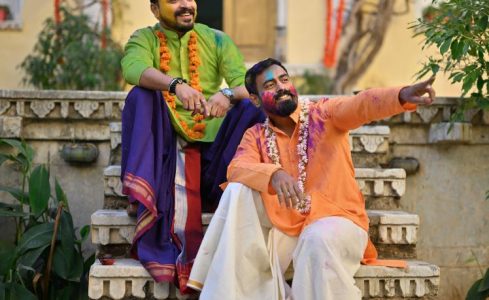
The Dhoti-Kurta remains a popular choice for men in Haryana due to its cultural significance and comfort. The dhoti, a long cloth wrapped around the waist, paired with a kurta, has deep roots in Haryana’s agricultural traditions.
It is particularly favoured during religious festivals, ceremonies, and community events. The dhoti-kurta symbolizes simplicity, cultural pride, and is seen as a mark of respect, especially among older men.
Despite modern influences, it continues to be worn in rural areas, reflecting the timeless connection to Haryana’s heritage. The varied draping styles of the dhoti across communities add to its versatility.
What Is the Cultural Importance of the Pagri (Turban) in Haryana?
The Pagri, or turban, holds immense cultural importance in Haryana, symbolizing honour, pride, and social status. Traditionally, the pagri is worn by men during special occasions like weddings, festivals, and religious ceremonies.
Different colours and styles of wrapping the pagri signify various communities and occasions. Red and saffron are often worn during festivals or as a mark of leadership.
More than just a headgear, the pagri represents dignity, particularly for elder men who continue to wear it daily, reflecting Haryana’s respect for tradition and values. This accessory completes the classic Haryanvi look, especially when paired with kurta-dhoti.
How Is the Traditional Jutti Footwear Significant in Haryana?
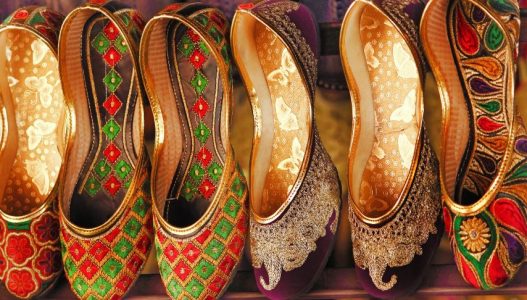
The Jutti is a key element of traditional attire in Haryana, known for its handcrafted design and comfort. Made from leather, juttis are slip-on shoes with intricate designs, often worn with kurta-pajama or dhoti-kurta.
The simplicity and durability of juttis make them ideal for both daily use and special occasions, particularly in rural areas. This traditional footwear is commonly available in natural tones or more decorative embroidered versions for festivals.
Juttis are not only practical but also reflect the craftsmanship and cultural heritage of Haryana, maintaining their relevance across generations.
Why Do Men Wear the Loi (Shawl) in Haryana During Winters?
The Loi, a woolen shawl, is essential winter wear for men in Haryana, offering both warmth and style. Traditionally worn over the shoulders, the loi is made from thick wool, perfect for the cold winter months in northern India.
This shawl is commonly seen in darker shades like brown or grey, and it complements the kurta-pajama or dhoti-kurta, adding a layer of elegance.
While primarily functional, the loi also represents Haryana’s rural traditions, providing protection against the harsh winters while reflecting the simplistic, yet stylish, fashion sensibility of the region’s men.
Top 10 Haryana Traditional Dress Male
1. Kurta-Pajama

Image – Source
The Kurta-Pajama is one of the most iconic traditional outfits for men in Haryana. Known for its simplicity and comfort, the kurta is a long tunic, typically white or beige, which falls just above the knees.
The pajama is a narrow-legged trouser, offering ease of movement, making it ideal for both daily wear and formal gatherings.
This attire is especially popular among the rural population and farmers, symbolizing Haryana’s deep connection to agriculture.
This versatile outfit can be paired with a turban or pagri, adding a touch of elegance to the overall look. While the kurta remains simple, some Haryanvi men prefer embroidered versions for festivals or special occasions, enhancing the classic appeal.
Whether at cultural festivals or casual events, the kurta-pajama remains a staple of Haryanvi tradition.
Kurta-Pajama Features
- Dress Name: Kurta (for men and women), Pajama (for men)
- Cultural Significance: Reflects the traditional Haryanvi rural lifestyle, often worn by farmers and villagers.
- Fabric & Material: Commonly made from cotton, linen, or khadi for breathability and comfort.
- Wearing Style: The kurta is loose-fitting and paired with a pajama or dhoti, designed for ease of movement.
- Traditional Accessories: Paired with turbans (for men), juttis, and simple jewellery like earrings or bangles (for women).
- Common Colour Schemes: Neutral shades like white, beige, and earthy tones, often paired with bright turbans for men.
- Market Availability & Cost: Widely available in local markets at budget-friendly prices, with handcrafted versions offered at a higher cost.
2. Dhoti-Kurta
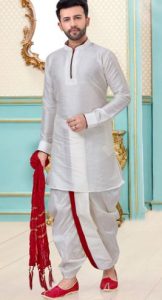
Image – Source
The Dhoti-Kurta is another timeless traditional outfit in Haryana, representing the rich cultural heritage of the state.
The dhoti is a long piece of cloth intricately wrapped around the waist and legs, while the kurta is a long tunic, adding both grace and comfort to the ensemble.
This attire is frequently worn during religious festivals, weddings, and community events, embodying the state’s rural charm. Dhoti styles often vary among different communities, with unique draping techniques that signify cultural differences.
The outfit is usually paired with a pagri or turban, adding dignity to the wearer’s appearance, especially during ceremonial occasions. The simplicity and elegance of the dhoti-kurta continue to make it a popular choice in Haryana.
Dhoti-Kurta Features
- Dress Name: Dhoti (for men), Kurta (for men and women)
- Cultural Significance: Worn during festivals and religious ceremonies, symbolizing cultural pride.
- Fabric & Material: Typically made of cotton or linen for a lightweight, breathable feel.
- Wearing Style: Dhoti is draped around the waist, while the kurta is worn as a tunic over the body.
- Traditional Accessories: Paired with a turban and traditional footwear like juttis.
- Common Colour Schemes: Primarily white, with variations in dhoti draping style by community.
- Market Availability & Cost: Available in rural markets, with handmade versions available at higher prices.
3. Pagri (Turban)
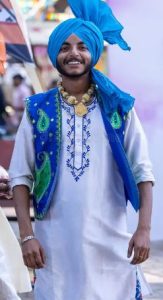
Image – Source
The Pagri, or turban, holds a significant place in the traditional attire of Haryanvi men, symbolizing honor, dignity, and pride. Typically made from a long piece of cloth, it is carefully wrapped around the head in a specific manner, signifying the wearer’s status or community.
Pagris are worn during festivals, religious ceremonies, and weddings, playing a key role in enhancing the overall traditional look. Haryanvi pagris come in various colours, with red and saffron being the most common, often used to denote cultural events or leadership.
The pagri is more than just a headgear—it’s an emblem of respect and pride, especially among elder men, who wear it as part of their daily attire.
Pagri Features
- Dress Name: Pagri or Turban (for men)
- Cultural Significance: Represents honour, pride, and cultural identity worn during special events.
- Fabric & Material: Usually made of cotton or silk for ceremonial pagris.
- Wearing Style: Wrapped around the head, with different styles depending on the community.
- Traditional Accessories: Often worn with a dhoti-kurta or kurta-pajama for ceremonial purposes.
- Common Colour Schemes: Saffron, red, white, and occasionally bright hues for festive occasions.
- Market Availability & Cost: These are available in local markets, and more elaborate versions are handcrafted.
4. Jutti (Footwear)
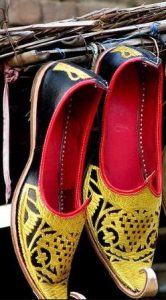
Image – Source
Juttis are traditional leather footwear commonly worn by men in Haryana. Known for their closed, slip-on design, juttis are handcrafted and often decorated with simple, intricate patterns.
This footwear pairs perfectly with both the kurta-pajama and dhoti-kurta outfits, making it a practical and comfortable choice for everyday wear and special occasions.
Juttis are lightweight and durable, making them ideal for the rugged terrains of rural Haryana. They are also available in a variety of designs, from plain leather to more ornate embroidered styles, catering to different tastes and occasions.
Jutti Features
- Dress Name: Jutti (for men and women)
- Cultural Significance: Traditional footwear that complements various Haryanvi outfits.
- Fabric & Material: Made from leather, sometimes with embroidered patterns.
- Wearing Style: Slip-on footwear covering the front half of the foot.
- Traditional Accessories: Often worn with kurta-pajama or dhoti-kurta for cultural events.
- Common Colour Schemes: Natural leather tones or dyed versions with embroidery.
- Market Availability & Cost: Easily available in local markets, with handcrafted designs being more expensive.
5. Loi (Shawl)
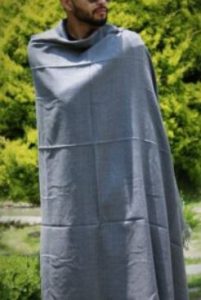
Image – Source
During the colder months, men in Haryana often wear a Loi, a woollen shawl that provides warmth and style.
The Loi is typically draped over the shoulders and is made from thick wool, making it perfect for the cold, harsh winters of northern India. It’s a practical addition to the traditional outfits of kurta-pajama or dhoti-kurta.
Aside from its functionality, the Loi adds a layer of elegance, particularly in rural areas where it’s an essential part of winter attire.
The shawl comes in neutral tones, such as dark browns or greys, aligning with the simplistic yet stylish aesthetic of Haryanvi men’s traditional clothing.
Loi Features
- Dress Name: Loi (for men)
- Cultural Significance: Provides warmth in winter and adds elegance to traditional outfits.
- Fabric & Material: Made from wool for its insulating properties.
- Wearing Style: Draped over the shoulders, sometimes tucked under the arms.
- Traditional Accessories: Often paired with juttis and a kurta-dhoti or kurta-pajama.
- Common Colour Schemes: Dark shades like brown, black, and grey.
- Market Availability & Cost: Easily found in local markets, with higher-end versions made from premium wool.
6. Angocha (Headscarf)
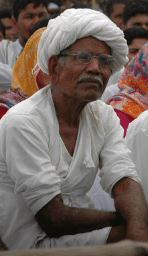
Image – Source
The Angocha is a small rectangular headscarf often worn by men in Haryana, especially in rural areas.
It serves multiple purposes, from providing protection from the sun and dust to acting as a handy accessory that adds a touch of style to everyday attire. Men commonly tie the angocha around their heads or necks while working outdoors.
While functional, the angocha can also be a stylish addition, complementing outfits such as the kurta-pajama or dhoti-kurta. Its vibrant colours and patterns make it a noticeable accessory in Haryanvi traditional attire.
Angocha Features
- Dress Name: Angocha or Gamchha (for men)
- Cultural Significance: Used for practical purposes like sun protection and dust control while adding a rustic charm.
- Fabric & Material: Typically made of lightweight cotton for breathability.
- Wearing Style: Worn around the head or neck, depending on the need.
- Traditional Accessories: Paired with simple traditional outfits, often used during manual labour.
- Common Colour Schemes: Bright colours with stripes or checkered patterns.
- Market Availability & Cost: Widely available in local markets at affordable prices.
7. Kurta with Embroidery
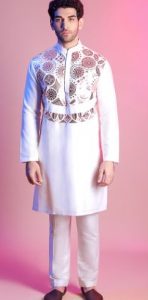
Image – Source
For more formal occasions, men in Haryana often opt for a Kurta with light embroidery or decorative buttons.
While the standard kurta-pajama is typically plain, embroidered kurtas are worn during festivals, weddings, or other ceremonial events. The intricate embroidery adds a touch of luxury and elegance, making the outfit suitable for festive gatherings.
The embroidery usually features subtle patterns along the neckline and sleeves, enhancing the otherwise simple outfit. Paired with a pagri and traditional footwear, this embellished kurta becomes a standout piece during celebrations.
Embroidered Kurta Features
- Dress Name: Embroidered Kurta (for men)
- Cultural Significance: Worn during festivals and special occasions to symbolize celebration and elegance.
- Fabric & Material: Made from cotton or silk, featuring light embroidery or ornate buttons.
- Wearing Style: Loose-fitting tunic with embroidery on the sleeves, collar, or neckline.
- Traditional Accessories: Paired with a pagri, juttis, and occasionally a waistcoat for added sophistication.
- Common Colour Schemes: White, beige, or pastel shades with colourful embroidery.
- Market Availability & Cost: Available in textile shops, with handcrafted embroidery versions being more expensive.
8. White Dhoti
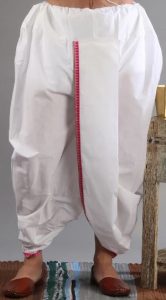
Image – Source
The White Dhoti holds a special place in Haryanvi men’s traditional attire, symbolizing simplicity and grace.
Often worn by older men and during religious events, the white dhoti is paired with a plain kurta for a minimalist yet dignified look. The attire is especially popular in rural settings, where it reflects cultural values of modesty and tradition.
Worn with a pagri or turban, the white dhoti is often seen during formal religious gatherings or ceremonies.
It continues to represent the enduring cultural legacy of Haryana, where simplicity is revered as an essential virtue.
White Dhoti Features
- Dress Name: Dhoti (for men)
- Cultural Significance: Reflects simplicity and cultural pride, especially during religious events.
- Fabric & Material: Made from soft, breathable cotton.
- Wearing Style: Draped around the waist and legs, often paired with a plain kurta.
- Traditional Accessories: Worn with a pagri, juttis, and occasionally a woollen shawl.
- Common Colour Schemes: Predominantly white, signifying purity.
- Market Availability & Cost: Widely available at low to mid-range prices in local markets.
9. Traditional Wedding Attire
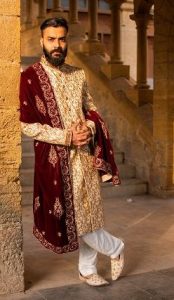
Image – Source
For special occasions such as weddings, men in Haryana opt for more ornate versions of their traditional outfits.
The traditional wedding attire typically consists of a richly embroidered kurta-dhoti or a sherwani, often in vibrant colours. The outfit is completed with an elaborate pagri, signifying honor and festivity.
In addition to embroidery, wedding attire for men may also include decorative elements such as brooches, embroidered vests, or silk shawls.
This grandeur reflects the significance of the occasion, making the groom’s attire a focal point of the celebration.
Traditional Wedding Attire Features
- Dress Name: Sherwani, Kurta-Dhoti (for men)
- Cultural Significance: Worn during weddings to symbolize festivity and grandeur.
- Fabric & Material: Made from rich fabrics such as silk or velvet, often with intricate embroidery.
- Wearing Style: Fitted attire with elaborate embellishments, worn with a formal pagri.
- Traditional Accessories: Paired with embroidered footwear (juttis) and decorative pagris.
- Common Colour Schemes: Red, gold, maroon, and other rich colours.
- Market Availability & Cost: Custom-made for weddings; high-end pricing depending on fabric and design.
10. Vest or Waistcoat
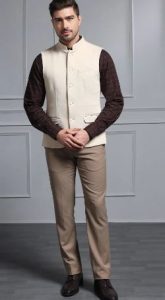
Image – Source
A vest or waistcoat is sometimes worn over the kurta for more formal events. This garment adds a touch of sophistication to the otherwise simple kurta-pajama outfit.
The vest is often made from complementary fabrics and may feature minimal embroidery to maintain the elegance of the attire.
In Haryana, wearing a waistcoat over traditional outfits is common for festivals, weddings, or public gatherings, where it enhances the overall appearance while keeping the attire rooted in tradition.
Vest or Waistcoat Features
- Dress Name: Waistcoat or Vest (for men)
- Cultural Significance: Adds sophistication and formality to traditional outfits.
- Fabric & Material: Made from materials like cotton, wool, or silk, sometimes with light embroidery.
- Wearing Style: Fitted waistcoat worn over the kurta or sherwani.
- Traditional Accessories: Paired with traditional Haryanvi footwear (juttis) and turbans for formal events.
- Common Colour Schemes: Neutral tones to match or complement the kurta.
- Market Availability & Cost: Available in formal wear shops, with handcrafted versions being more expensive.
Conclusion
The traditional male attire of Haryana not only showcases the region’s cultural richness but also its practical sensibilities. Outfits like the kurta-pajama, dhoti-kurta, and jutti blend comfort with heritage, making them integral to everyday life and special occasions.
The symbolic pagri, the protective loi, and the ornate wedding attire offer a glimpse into the pride and honour that these clothes represent. These garments are more than just fabric—they are woven with values of simplicity, dignity, and respect for tradition.
As modern influences blend with these time-honoured styles, Haryana’s traditional male dress continues to be a timeless expression of cultural identity and elegance.
FAQs
What is the traditional dress of Haryana?
The traditional dress of Haryana includes a kurta and pajama for men, while women wear a kurta paired with either a ghagra or salwar.
What fabric is commonly used in Haryana’s traditional clothing?
Cotton, linen, and khadi are popular fabrics due to their comfort and breathability, suitable for the region’s climate.
What accessories are worn with Haryana’s traditional attire?
Men often wear a turban and juttis, while women accessorize with earrings, bangles, and anklets.
When is traditional Haryanvi clothing worn?
Traditional attire is worn daily in rural areas and during festivals, weddings, and cultural events across the state.
What are the popular colours in Haryanvi traditional dress?
Neutral colours like white and beige are common, with men adding bright-coloured turbans, and women choosing vibrant dupattas.
Where can I buy traditional Haryanvi clothing?
Traditional Haryanvi clothing is available in local markets, and handwoven or customized versions can be found in urban shops and online.

